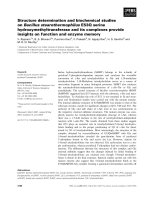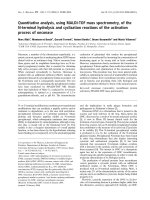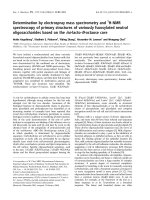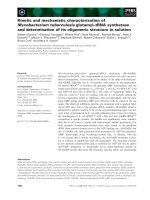facilitation of protein three-dimensional structure determination using enhanced peptide amide deuterium exchange mass spectrometry (dxms)
Bạn đang xem bản rút gọn của tài liệu. Xem và tải ngay bản đầy đủ của tài liệu tại đây (6.32 MB, 270 trang )
UNIVERSITY OF CALIFORNIA, SAN DIEGO
FACILITATION OF PROTEIN 3-D STRUCTURE DETERMINATION USING
ENHANCED PEPTIDE AMIDE
DEUTERIUM EXCHANGE MASS SPECTROMETRY (DXMS)
A dissertation submitted in partial satisfaction of the
requirements for the degree Doctor of Philosophy
in
Biomedical Sciences
by
Dennis Peter Pantazatos
Committee in charge:
Professor Virgil L. Woods Jr., Chair
Professor Philip Bourne
Professor Jeff Esko
Professor Mortin Printz
Professor Fransisco Villareal
2006
UMI Number: 3205364
3205364
2006
Copyright 2006 by
Pantazatos, Dennis Peter
UMI Microform
Copyright
All rights reserved. This microform edition is protected against
unauthorized copying under Title 17, United States Code.
ProQuest Information and Learning Company
300 North Zeeb Road
P.O. Box 1346
Ann Arbor, MI 48106-1346
All rights reserved.
by ProQuest Information and Learning Company.
ii
Copyright
Dennis Peter Pantazatos, 2006
All rights reserved.
ii
iii
The dissertation of Dennis Peter Pantazatos is approved, and is acceptable in quality and
form for publication on microfilm:
__________________________________________________________________
__________________________________________________________________
__________________________________________________________________
__________________________________________________________________
__________________________________________________________________
__________________________________________________________________
Chair
University of California, San Diego
2006
iii
iv
DEDICATION
This dissertation is dedicated in loving memory of my father
whose early inspiration led me along my life's path, my brother,
and for my loving mother whose strength and courage have taught me how to endure.
iv
v
EPIGRAPH
"It's not the accomplishments in life that help you grow
but the experience of the journey.
”
Dennis Peter Pantazatos
v
vi
TABLE OF CONTENTS
DEDICATION IV
EPIGRAPH V
TABLE OF CONTENTS VI
LIST OF FIGURES AND TABLES XI
ACKNOWLEDGEMENTS XV
CURRICULUM VITA XVII
ABSTRACT OF THE DISSERTATION XIX
CHAPTER 1……………………………………………………………………………1
HYDROGEN/DEUTERIUM EXCHANGE MASS SPECTROMETRY FOR
INVESTIGATING PROTEIN-LIGAND INTERACTIONS
1.1 ABSTRACT 1
1.2 INTRODUCTION 2
1.3 STANDARD APPROACHES FOR HIGH-RESOLUTION PROTEIN
STRUCTURE ANALYSIS
3
1.4 THEORY OF HYDROGEN EXCHANGE 4
1.5 AMIDE HYDROGEN/DEUTERIUM EXCHANGE STUDIES 5
1.6 EX1 AND EX2 KINETICS FOR HYDROGEN/DEUTERIUM EXCHANGE 8
1.7 HYDROGEN/DEUTERIUM EXCHANGE MASS SPECTROMETRY 9
1.8 INSTRUMENTATION AND DATA ANALYSIS 10
vi
vii
1.9 THROMBIN-LEPIRUDIN COMPLEX: MODEL STUDIES USING
HYDROGEN/DEUTERIUM EXCHANGE MASS SPECTROMETRY
11
1.10 MAPPING LEPIRUDIN BINDING SITES ON THROMBIN 12
1.11 ALLOSTERIC CHANGES IN THROMBIN STRUCTURE INDUCED BY
LEPIRUDIN BINDING
13
1.12 RESOLVING CONFORMATIONAL CHANGES AND LIGAND BINDING 15
1.13 HYDROGEN/DEUTERIUM EXCHANGE TO CHARACTERIZE DRUG-
PROTEIN INTERACTIONS
17
1.14 CONCLUSION 18
1.15 ACKNOWLEDGEMENTS 19
1.16 REFERENCES 27
CHAPTER 2………………………………………………………………………… 32
HIGH RESOLUTION DEFINITION OF THE STABILITY LANDSCAPE OF
CHICKEN BRAIN α-SPECTRIN (R1617) WITH ENHANCED
HYDROGEN/DEUTERIUM EXCHANGE MASS SPECTROMETRY (DXMS):
IMPLICATIONS FOR THE BASIS OF SPECTRIN ELASTICITY
2.1 ABSTRACT 32
2.2 INTRODUCTION 34
2.3 METHODS 38
2.4 RESULTS 42
2.5 DISCUSSION 54
2.6 ACKNOWLEDGEMENTS 60
2.7 SUPPLEMENTAL MATERIAL 62
vii
viii
2.8 REFERENCES 74
CHAPTER 3………………………………………………………………………… 78
MOLECULAR INTERACTIONS BETWEEN MATRILYSIN AND THE
MATRIX METALLOPROTEINASE INHIBITOR DOXYCYCLINE
INVESTIGATED BY DEUTERIUM EXCHANGE MASS SPECTROMETRY
3.1 ABSTRACT 78
3.2 INTRODUCTION 79
3.3 METHODS 83
3.4 RESULTS 89
3.5 DISCUSSION 105
3.6 ACKNOWLEDGEMENTS. 110
3.7 REFERENCES 111
CHAPTER 4………………………………………………………………………….115
RAPID REFINEMENT OF CRYSTALLOGRAPHIC PROTEIN CONSTRUCT
DEFINITION EMPLOYING ENHANCED HYDROGEN/ DEUTERIUM
EXCHANGE MASS SPECTROMETRY (DXMS)
4.1 ABSTRACT 115
4.2 INTRODUCTION 116
4.3 METHODS 120
4.4 RESULTS 123
4.5 DISCUSSION 128
4.6 ACKNOWLEDGMENTS 129
4.7 SUPPLEMENTAL MATERIALS 137
viii
ix
4.8 REFERENCES 144
CHAPTER 5………………………………………………………………………….147
ON THE USE OF DXMS TO PRODUCE MORE CRYSTALLIZABLE
PROTEINS – STRUCTURES OF THE THERMOTOGA PROTEINS TM0160
AND TM1171
5.1 ABSTRACT 147
5.2 INTRODUCTION 148
5.3 METHODS 150
5.4 RESULTS 159
5.5 DISCUSSION 169
5.6 ACKNOWLEDGEMENTS 171
5.7 REFERENCES 189
CHAPTER 6………………………………………………………………… …….193
METHODS FOR THE DETERMINATION OF PROTEIN THREE-
DIMENSIONAL STRUCTURE EMPLOYING HYDROGEN EXCHANGE
ANALYSIS TO REFINE COMPUTATIONAL STRUCTURE PREDICTION
6.1 ABSTRACT 193
6.2 INTRODUCTION 196
6.3 RESULTS 208
6.4 ACKNOWLEDGMENTS 221
6.5 REFERENCES 231
CHAPTER 7………………………………… ………………….………………….241
SUMMARY AND FUTURE DIRECTIONS
ix
x
7.1 REFERENCES 248
x
xi
LIST OF FIGURES AND TABLES
Figure 1-1: Schematic representation of hydrogen/deuterium exchange mass
spectrometry procedure.
20
Figure 1-2: Flow chart depicting automated protein processing and data analysis 21
Figure 1-3: Refinement of mass spectrometry data for peptide identification 22
Figure 1-4(A): Thrombin-Lepirudin Complex 23
Figure 1-4(B): Thrombin-Lepirudin Complex. 24-25
Figure 1-5: Ribbon diagram of thrombin-hirudin complex 26
Figure 2-1: Spectrin Fragmentation map: Comparison of the fragments generated by
pepsin and pepsin plus FPXIII is shown.
49
Figure 2-2: Deuterium accumulation plots for pepsin generated peptides of spectrin. 50
Figure 2-3: Composite spectrin fragmentation map, manual rate map, and High
Resolution exchange rate map.
51
Figure 2-4 Overlay of the COREX-calculated and experimentally-determined protection
factor profiles deduced for α-spectrin R1617.
52
Figure 2-5: Mapping of exchange rate classes on to the 3-D crystal structure of the
alpha spectrin R1617 construct:
53
Figure 2-6: the definition of the AU for the first 15 amino acid segment of R1617 71
Figure 2-7: HR-DXMS deconvolution of Spectrin simulated data: 72
xi
xii
Figure 2-8: Validation of HR-DXMS by producing simulated DXMS deuterated
fragment datasets based on published NMR-determined experimental hydrogen
exchange rate data from horse cytochrome c
73
Figure 3-1: Determination of dissociation constant (Kd) and binding stoichometry for
doxycycline-matrilysin complex by equilibrium dialysis.
95
Figure 3-2: Doxycycline inhibits degradation of native collagen by matrilysin 96
Figure 3-3: Amide hydrogen/deuterium exchange maps for matrilysin. 97
Figure 3-4: Time-dependent deuterium incorporation of matrilysin-doxycycline
complex.
99
Figure 3-5A: Deuterium incorporation for peptides at the amino and carboxyl termini of
Matrilysin in relation to the three-dimensional structure.
100
Figure 3-5B: Deuterium incorporation for peptides at the zinc-binding regions of
matrilysin (residues 156-175, Zn
struct
; residues 210-230, Zn
cat
) 101
Figure 3-5C: Deuterium incorporation for peptides in matrilysin at the putative
doxycycline-binding regions (residues 145-153; residues 193-204).
102
Figure 3-6: Probing conformation changes in matrilysin induced by doxycycline 103
Figure 3-7: Schematic depiction of matrilysin inhibition by doxycycline 104
Figure 4-1: 10- second deuteration results for 21 proteins analyzed by DXMS. 131
Figure 4-2A: 10-second amide hydrogen/ deuterium exchange map for TM0449 132
Figure 4-3: The on-exchange map of TM0505 133
Figure 4-4: The on-exchange maps of TMTM1171 and TM0160 134
Table 4-1: Description of T. maritima proteins studied, as classified by crystallization
history
135-136
xii
xiii
Figure 4-5: Summary of DXMS analysis of 21 T. Maritima proteins. 140-143
Table 4-2: Summary of Data Collection and Refinement Statistics for TM0160 and
TM1171
172
Figure 5-1A: DXMS time exchange data and sequence alignments for TM0160 and
TM1171.
174
Figure 5-1B: Sequence Alignment of TM1060 and its closest homologues 175
Figure 5-1C: Structural alignment of TM1171 and its two closest structural
homologues
177
Figure 5-2A,C: Structure of TM0160 179-180
Figure 5-2B,D: Structure of TM0160 181-182
Figure 5-3: Putative active site region for TM0160 183-184
Figure 5-4: Overall Structure of TM1171. 185-186
Figure 5-5: Comparison of TM1171 with E. coli transcription regulator. R 187
Figure 5-6: Superposition of TM1171 cNTP domain with its counterpart in E. coli.188
(PDB code 1RUN [PDB] ). 188
Figure 6-1A: Deuterium on exchange: 222
Figure 6-1B: Deuterium localization and quantification: 223
Figure 6-2: an example of validation studies of HR-DXMS de-convolution HR-DXMS
deconvolution of Cytochrome-c
224
Figure 6-3: high-density fragmentation DXMS data on a 221 aa two-tandem- repeat
construct of chicken brain α-spectrin (16th-17th repeats).
225
Figure 6-4A: Structure predictions for CASP4 target protein #102 226
Figure 6-4B: Structure predictions for CASP4 target protein #102 227
xiii
xiv
Figure 6-5: analysis of the relationship between variance in protein 3-D structure
prediction accuracy and variance in COREX- calculated exchange-rate fingerprints
for prediction vs. true structures
228
Figure 6-6: Ten-second amide hydrogen/deuterium exchange map for one of the
proteins studied, TM1079.
229
Figure 6-7: Deuteration results for all of the 21 proteins that were analyzed using
DXMS for surface exposed residues.
230
Figure 7-1: Table listing ongoing structural genomics initiatives 247
xiv
xv
ACKNOWLEDGEMENTS
First, I would like to thank my family for their tremendous support and love, Virgil
Woods for creating an environment of flexibility and independence as a graduate
student. I thank my entire thesis committee and the BMS faculty and staff for their
continued support throughout my graduate years. Finally I would like to thank Angelo
Gaitos and Angela Pantazatos for their assistance in the formatting of this dissertation.
And many thanks to Iva Smith for her review and editing of the dissertation. Also many
thanks to all the members of the Woods lab: Jack Kim, who ran many of the samples,
Chris Gessner, who was invaluable in managing the informatics, data storage and
assisting in the data analysis and Krissi Hewitt who also assisted me in data analysis.
Further I would like to thank Phil Bourne for his encouraging support and development
of my ideas, and James Torrance who aided in the DXMS-COREX simulation studies
reported in Chapter VI. I would also like to acknowledge Vince Hilser and his lab
(UTMB) for assisting me on the use of the COREX algorithm and David Baker and his
lab (University of Washington) for their assistance and advice on using Rosetta.
Chapter 1, is a reprint of the material as it appears in Garcia, R.A., D.
Pantazatos, and F.J. Villarreal. 2004. “Hydrogen/deuterium exchange mass
spectrometry for investigating protein-ligand interactions.” Assay Drug Dev Technol
2:81-91. Chapter 2, in full, will be submitted for publication in the Journal of Molecular
Biology with coauthors Chris Gessner, Jack S. Kim, Krissi Hewett, Vincent J. Hilser,
xv
xvi
Steven T. Whitten, Ruby I. MacDonald and Virgil L. Woods, Jr. Chapter 3, is a reprint
of the material as it appears in Garcia, R.A., D.P. Pantazatos, C.R. Gessner, K.V. Go,
V.L. Woods, Jr., and F.J. Villarreal. 2005. “Molecular interactions between matrilysin
and the matrix metalloproteinase inhibitor doxycycline investigated by deuterium
exchange mass spectrometry.” Mol Pharmacol 67:1128-1136. Chapter 4, is a reprint of
the material as it appears in Pantazatos, D., J.S. Kim, H.E. Klock, R.C. Stevens, I.A.
Wilson, S.A. Lesley, and V.L. Woods, Jr. 2004.” Rapid refinement of crystallographic
protein construct definition employing enhanced hydrogen/deuterium exchange MS.”
Proc Natl Acad Sci U S A 101:751-756. Chapter 5, is a reprint of the material as it
appears in Spraggon, G., D. Pantazatos, H.E. Klock, I.A. Wilson, V.L. Woods, Jr., and
S.A. Lesley. 2004. “On the use of DXMS to produce more crystallizable proteins:
structures of the T. maritima proteins TM0160 and TM1171.” Protein Sci 13:3187-
3199. Chapter 6, is taken in part as it appears in US/PCT Patent Application #
PCT/US2004/036456, “Methods for the Determination of Protein Three-Dimensional
Structure Employing Hydrogen Exchange Analysis to Refine Computational Structure
Prediction” filed November 1, 2004. Assignee: Regents, University of California with
couthors V.L. Woods Jr., P. Bourne, V. Hilser, and H. White.
xvi
xvii
CURRICULUM VITA
1990 BS Biomedical Engineering, Northwestern University Evanston, IL
1996 MS Human Genetics, University of Michigan Ann Arbor, MI
2006 Ph.D., Biomedical Sciences University of California San Diego, CA
PUBLICATIONS
1. Kurachi, S., D.P. Pantazatos, and K. Kurachi. 1997. The carboxyl-terminal
region of factor IX is essential for its secretion. Biochemistry 36:4337-4344.
2. Pantazatos, D.P., and R.I. MacDonald. 1997. Site-directed mutagenesis of either
the highly conserved Trp-22 or the moderately conserved Trp-95 to a large,
hydrophobic residue reduces the thermodynamic stability of a spectrin repeating
unit. J Biol Chem 272:21052-21059.
3. MacDonald, R.C., G.W. Ashley, M.M. Shida, V.A. Rakhmanova, Y.S.
Tarahovsky, D.P. Pantazatos, M.T. Kennedy, E.V. Pozharski, K.A. Baker, R.D.
Jones, H.S. Rosenzweig, K.L. Choi, R. Qiu, and T.J. McIntosh. 1999. Physical
and biological properties of cationic triesters of phosphatidylcholine. Biophys J
77:2612-2629.
4. Pantazatos, D.P., and R.C. MacDonald. 1999. Directly observed membrane
fusion between oppositely charged phospholipid bilayers. J Membr Biol 170:27-
38.
5. Garcia, R.A., S.P. Pantazatos, D.P. Pantazatos, and R.C. MacDonald. 2001.
Cholesterol stabilizes hemifused phospholipid bilayer vesicles. Biochim Biophys
Acta 1511:264-270.
6. Pantazatos, D.P., S.P. Pantazatos, and R.C. MacDonald. 2003. Bilayer mixing,
fusion, and lysis following the interaction of populations of cationic and anionic
phospholipid bilayer vesicles. J Membr Biol 194:129-139.
7. Garcia, R.A., D. Pantazatos, and F.J. Villarreal. 2004. Hydrogen/deuterium
exchange mass spectrometry for investigating protein-ligand interactions. Assay
Drug Dev Technol 2:81-91.
xvii
xviii
8. Pantazatos, D., J.S. Kim, H.E. Klock, R.C. Stevens, I.A. Wilson, S.A. Lesley,
and V.L. Woods, Jr. 2004. Rapid refinement of crystallographic protein
construct definition employing enhanced hydrogen/deuterium exchange MS.
Proc Natl Acad Sci U S A 101:751-756.
9. Spraggon, G., D. Pantazatos, H.E. Klock, I.A. Wilson, V.L. Woods, Jr., and S.A.
Lesley. 2004. On the use of DXMS to produce more crystallizable proteins:
structures of the T. maritima proteins TM0160 and TM1171. Protein Sci
13:3187-3199.
10. Pantazatos, D., V.L. Woods Jr., P. Bourne, V. Hilser, and H. White. Methods for
the Determination of Protein Three-Dimensional Structure Employing Hydrogen
Exchange Analysis to Refine Computational Structure Prediction. US/PCT
Patent Application # PCT/US2004/036456, filed November 1, 2004. Assignee:
Regents, University of California.
11. Garcia, R.A., D.P. Pantazatos, C.R. Gessner, K.V. Go, V.L. Woods, Jr., and F.J.
Villarreal. 2005. Molecular interactions between matrilysin and the matrix
metalloproteinase inhibitor doxycycline investigated by deuterium exchange
mass spectrometry. Mol Pharmacol 67:1128-1136.
Abstracts:
1. Pantazatos, D.P., J.S. Kim, and V.L. Woods Jr. 2002. Rapid, High Resolution
Definition of Conformational Changes that Occur in Thrombin Upon Binding to
Hirudin Employing Enhanced Hydrogen- Deuterium Exchange- Mass
Spectrometry (DXMS). Blood 100:259a.
2. Pantazatos, D.P., R.I. MacDonald, J.S. Kim, and V.L. Woods Jr. 2002.
Molecular Mechanism of Spectrin Elasticity Probed by Enhanced Amide
Hydrogen-Deuterium Exchange Mass Spectrometry (DXMS). Blood 100:259a.
xviii
xix
ABSTRACT OF THE DISSERTATION
FACILITATION OF PROTEIN 3-D STRUCTURE
DETERMINATION USING ENHANCED PEPTIDE AMIDE
DEUTERIUM EXCHANGE MASS SPECTROMETRY (DXMS)
by
Dennis Peter Pantazatos
Doctor of Philosophy in Biomedical Sciences
University of California, San Diego, 2006
Professor Virgil L. Woods Jr., Chair
Three dimensional structure determination and analysis of proteins is necessary
for the understanding of how proteins participate in human disease, and are critical for
the effective design of therapeutics for clinically important targets. Current efforts for
determining protein structures are centered on novel high-throughput (HT) approaches.
These include high throughput (HT) crystallization efforts
and global structure
prediction efforts monitored through the Critical Assessment of Structure Prediction
xix
xx
(CASP) experiments where progress has been incremental at best. Protein structure
analysis of conformational changes and protein-proteins interactions can be monitored
by biophysical methods which include fluorescence spectroscopy, differential scanning
calorimetry, circular dichroism and ultra centrifugation. These methods provide
adequate low resolution information on global changes in secondary and tertiary
structure but are limited in providing detailed information on protein structure, protein
conformational changes and protein-protein interactions. Therefore, there is a great need
for improvements in the speed and ease of determining and analyzing protein structures
and protein dynamics. Hydrogen/Deuterium (H/D) exchange rates are highly dependent
on protein structure and amide hydrogen solvent accessibility. Exchange rates can
report structure stability at the individual amino acid scale and provide important
information on the secondary and tertiary structure.
The dissertation is arranged as follows:
Chapter 1 is an introduction to Hydrogen/Deuterium exchange mass spectrometry and
also reports my studies on the thrombin-Lepirudin complex.
Chapter 2 is in preparation for submission and reports the application of DXMS for
characterizing the molecular dynamics of spectrin. It also presents the development and
validation studies for a computational method for generating amide exchange rate maps
from DXMS data, a critical component of the structure determination method described
in Chapters six and seven.
Chapter 3 reports the application of DXMS for structural analysis of drug-protein
interactions.
xx
xxi
Chapter 4 reports methods for using DXMS to improve the crystallizability of protein
constructs for 3D structure determination by x ray crystallography.
Chapter 5 reports the detailed 3-D structures of the first two proteins that were
successfully studied with the DXMS- guided construct design method.
Chapter 6 outlines the development of a hybrid computational-experimental method
for high-throughput protein 3-D structure determination: DXMS-Rosetta-COREX
engine.
Chapter 7
summarizes my conclusions from the foregoing studies and outlines future
directions of these studies.
xxi
CHAPTER 1
HYDROGEN/DEUTERIUM EXCHANGE MASS
SPECTROMETRY FOR INVESTIGATING PROTEIN-LIGAND
INTERACTIONS
1.1 ABSTRACT
Amide hydrogen/deuterium exchange mass spectrometry is rapidly becoming a
powerful method for high-resolution analyses of protein dynamics, structure, and
function. Hydrogen/deuterium exchange approaches can provide information that greatly
augments and refines information derived from high-resolution structural studies, and can
provide detailed information on native protein structure when structural information is
unavailable. Application of this method for rapid analyses of protein-ligand complexes
could prove useful for studies of important disease-related protein complexes. The
following review covers fundamentals of hydrogen/deuterium exchange and its
applications to the study of protein-ligand complexes. In addition, hydrogen/deuterium
exchange mass spectrometry studies on a protein-inhibitor complex are presented.
1
2
1.2 INTRODUCTION
Changes in protein tertiary structure, protein dynamics (i.e. movement), and
association state are critical for the proper function of many protein systems. Anomalous
alterations in these properties can affect normal protein function, and in some cases
compromise cell viability. Detailed structural investigations of these protein systems can
therefore aid in understanding the causal relationships between protein structure and
normal or abnormal physiological function.
In this era of proteomics and molecular medicine, mass spectrometry has become
a powerful platform for profiling proteins in disease. High accuracy measurements of
protein mass (via mass-to-charge ratio), rapid turnover of experiments, instrument
automation, and ready access to protein sequence databases have made mass
spectrometry one of the technologies of choice for the systematic study of proteins. More
recent applications of mass spectrometry to characterize protein structural changes have
shown great promise. One such approach utilizes isotopic labeling of proteins via amide
hydrogen/deuterium exchange followed by proteolytic fragmentation of labeled protein
and analysis by mass spectrometry. Hydrogen/deuterium exchange mass spectrometry
has been used to track structural changes in proteins involved in processes such as viral
infection
1,2
, blood coagulation
3-5
and kinase-mediated signal transduction
6-11
. Specific
application of hydrogen/deuterium exchange to study key disease-related proteins could
aid in understanding the mechanisms by which these proteins function during disease
progression.
3
The use of amide hydrogen/deuterium exchange to study protein structure,
dynamics, protein-protein interfaces, and small-molecule ligand-binding sites is the
subject of this review. What follows is an overview of the theory of amide hydrogen
exchange, experiment methodology, and potential applications of hydrogen/deuterium
exchange in drug development and proteomics research. In addition, model studies to
look at protein-ligand interactions with the serine protease thrombin and a potent
thrombin inhibitor, lepirudin, are presented.
1.3 STANDARD APPROACHES FOR HIGH-RESOLUTION PROTEIN
STRUCTURE ANALYSIS
Nuclear magnetic resonance spectroscopy (NMR) and X-ray crystallography
remain the standards to which all other protein structural methods must be compared.
NMR spectroscopy provides detailed information on structural, thermodynamic, and
kinetic properties of proteins. NMR is particularly well suited for molecular
characterization of three-dimensional protein structure and protein dynamics in
physiological-like solutions. Advancements in NMR have made structural analyses of
proteins in the 30 - 40 kDa range more routine
12
. Larger proteins, however, are not
routine. Molecular mass (> ~40 kDa) therefore represents the major limitation of NMR.
X-ray crystallographic methods also provide high-resolution structural information of
proteins. Although the structures are static, many different physiologically-relevant
states of a protein may be resolved using the appropriate conditions. One major
limitation of protein crystallography is the crystallization process itself; some proteins are









